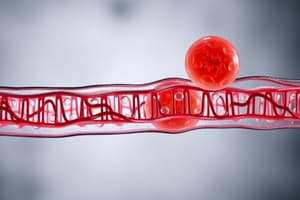Podcast
Questions and Answers
Which of the following best describes the role of cholesterol within the cell membrane?
Which of the following best describes the role of cholesterol within the cell membrane?
- Primarily provides structural rigidity, preventing the membrane from becoming too stiff.
- Functions as a channel for the transport of large, polar molecules across the membrane.
- Facilitates cell-to-cell recognition, aiding in immune responses and tissue formation.
- Increases membrane fluidity, especially at low temperatures, and stabilizes the membrane at high temperatures. (correct)
The plasma membrane is equally permeable to all substances, allowing any molecule to pass through freely.
The plasma membrane is equally permeable to all substances, allowing any molecule to pass through freely.
False (B)
Compare and contrast facilitated diffusion and active transport, highlighting their mechanisms and energy requirements.
Compare and contrast facilitated diffusion and active transport, highlighting their mechanisms and energy requirements.
Facilitated diffusion uses transport proteins to move substances down their concentration gradient without energy, while active transport moves substances against their concentration gradient using energy (ATP).
In a ________ environment, an animal cell may undergo lysis due to excessive water intake, whereas a plant cell becomes ________, exhibiting increased turgor pressure.
In a ________ environment, an animal cell may undergo lysis due to excessive water intake, whereas a plant cell becomes ________, exhibiting increased turgor pressure.
Match the following processes with their correct descriptions:
Match the following processes with their correct descriptions:
Which of the following is the primary reason animal cells undergo lysis in a hypotonic environment, while plant cells do not?
Which of the following is the primary reason animal cells undergo lysis in a hypotonic environment, while plant cells do not?
Active transport always moves molecules from an area of high concentration to an area of low concentration.
Active transport always moves molecules from an area of high concentration to an area of low concentration.
Explain the Fluid Mosaic Model of the plasma membrane, detailing its components and their arrangements.
Explain the Fluid Mosaic Model of the plasma membrane, detailing its components and their arrangements.
__________ is a type of endocytosis that involves the ingestion of large particles or cells, while _________ involves the ingestion of liquid into a cell by the budding of small vesicles from the cell membrane.
__________ is a type of endocytosis that involves the ingestion of large particles or cells, while _________ involves the ingestion of liquid into a cell by the budding of small vesicles from the cell membrane.
Which of the following best describes the role of transport proteins in facilitated diffusion?
Which of the following best describes the role of transport proteins in facilitated diffusion?
Flashcards
What is a cell?
What is a cell?
Basic structural feature of life; can be prokaryotic or eukaryotic.
What is the plasma membrane?
What is the plasma membrane?
Regulates entry/exit of substances; composed of a phospholipid bilayer and proteins.
What does semi-permeable mean?
What does semi-permeable mean?
Membrane allows some substances to pass more easily than others.
What is diffusion?
What is diffusion?
Signup and view all the flashcards
What is osmosis?
What is osmosis?
Signup and view all the flashcards
What is facilitated diffusion?
What is facilitated diffusion?
Signup and view all the flashcards
What is an isotonic environment?
What is an isotonic environment?
Signup and view all the flashcards
What is a hypertonic environment?
What is a hypertonic environment?
Signup and view all the flashcards
What is a hypotonic environment?
What is a hypotonic environment?
Signup and view all the flashcards
What is endocytosis?
What is endocytosis?
Signup and view all the flashcards
Study Notes
- Completion of this unit enables students to explain and compare cellular structure and function, and analyze the cell cycle, cell growth, death, and differentiation.
Cellular Structure and Function
- Cells are the basic structural unit of life on Earth
- Distinctions exist between prokaryotic and eukaryotic cells
- Both plant and animal cells have organelles
- Plant and animal cell organelles have distinct functions, including chloroplasts and mitochondria
- The plasma membrane's structure and function is to control the passage of water, hydrophilic and hydrophobic substances via osmosis, facilitated diffusion, and active transport
Cell Membrane Diagram
- Key components of the cell membrane include: Cholesterol, Glycolipid, Glycoprotein, Phospholipid, Phospholipid bilayer, Channel and Carrier Protein
- Cell membranes are semi-permeable or selectively permeable
- Cholesterol maintains membrane fluidity, whereas glycolipids and glycoproteins are involved in cell recognition and signaling
- Transport proteins facilitate the movement of specific molecules across the membrane
- Two types of transport proteins exist: channel proteins and carrier proteins
- The fluid mosaic model describes the structure of the plasma membrane
- Plasma membranes have various functions, including regulating transport, cell signaling, and cell adhesion
Membrane Transport
- Active transport requires energy, whereas passive transport does not
- Types of passive transport: Osmosis, Diffusion, and Facilitated diffusion
- Processes like Diffusion, Osmosis, and Facilitated Diffusion enable molecules to move across the membrane
- Hypertonic solutions cause cells to shrink, hypotonic solutions cause cells to swell, and isotonic solutions have no effect on cell volume
- In hypertonic environments, animal cells shrink; in hypotonic environments, they may lyse
- In hypertonic environments, plant cells plasmolyze; in hypotonic environments, they become turgid
- Lysis is the bursting of a cell
- Turgid refers to a cell being swollen and rigid due to water uptake
- Plasmolysis is the contraction of the protoplast of a plant cell as a result of loss of water from the cell
- Animal cells undergo lysis in hypotonic environments due to water influx
- Active transport requires energy to move molecules against their concentration gradient
- Endocytosis is the process of cells engulfing substances.
- Exocytosis is the process of cells expelling substances.
- Facilitated diffusion uses transport proteins to aid movement down the concentration gradient, while active transport uses energy to move molecules against the concentration gradient
Transport Proteins
- Transport proteins are involved in facilitated diffusion
- Transport proteins are involved in active transport
- Glucose is transported via facilitated diffusion
- Carbon dioxide is transported via simple diffusion
- Amino acids are transported via active transport or facilitated diffusion
- Oxygen is transported via simple diffusion
- Lipophilic drugs are transported via simple diffusion
- Chloride ions are transported via facilitated diffusion
- Magnesium ions are transported via facilitated diffusion
- Ethanol is transported via simple diffusion
- Steroids are transported via simple diffusion
- Sodium ions are transported against the concentration gradient via active transport
- Water is transported via osmosis
- Potassium ions are transported via active transport
- Alcohol is transported via simple diffusion
- Chloroform is transported via simple diffusion
- Calcium ions are transported via active transport or facilitated diffusion
Key Words
- Plasma membrane: The outer boundary of a cell that regulates what enters and exits
- Intracellular: Inside the cell
- Extracellular: Outside the cell
- Phospholipid: A lipid containing a phosphate group in its molecule
- Selectively Permeable: Allows certain substances to pass through
- Semi-Permeable: Selectively permeable
- Phosphate head: The hydrophilic, polar portion of a phospholipid
- Fatty acid chain: The hydrophobic, nonpolar portion of a phospholipid
- Fluid Mosaic: A model of the cell membrane structure
- Cholesterol: A lipid that helps maintain membrane fluidity
- Glycolipid: A lipid with a carbohydrate attached
- Glycoprotein: A protein with a carbohydrate attached
- Phospholipid bilayer: A double layer of phospholipids that forms the cell membrane
- Polar: Having an uneven distribution of charge
- Nonpolar: Having an even distribution of charge
- Hydrophilic: Attracted to water
- Hydrophobic: Repelled by water
- Amphipathic: Having both hydrophilic and hydrophobic parts
- Transport Protein: A protein that helps move substances across the cell membrane
- Carrier Protein: A protein that binds to a specific substance and transports it across the cell membrane
- Channel Protein: A protein that forms a channel through which specific substances can pass
- Cell membrane: The outer boundary of a cell that regulates what enters and exits
- Active Transport: Movement of molecules across the cell membrane against their concentration gradient, requiring energy
- Passive Transport: Movement of molecules across the cell membrane down their concentration gradient, without requiring energy
- Concentration gradient: The difference in concentration of a substance across a space
- Diffusion: The movement of molecules from an area of high concentration to an area of low concentration
- Osmosis: The movement of water across a semi-permeable membrane from an area of high water concentration to an area of low water concentration
- Hypotonic: Having a lower solute concentration than another solution
- Isotonic: Having the same solute concentration as another solution
- Hypertonic: Having a higher solute concentration than another solution
- Facilitated Diffusion: The movement of molecules across the cell membrane with the help of transport proteins
- Lysis: The bursting of a cell
- Turgid: Swollen and rigid due to water uptake
- Plasmolysis: The contraction of the protoplast of a plant cell as a result of loss of water from the cell
- Solute: A substance that is dissolved in a solvent
- Solvent: A substance that dissolves a solute
- Solution: A mixture of a solute and a solvent
- Sodium-Potassium Pump: A transport protein that pumps sodium ions out of the cell and potassium ions into the cell
- Endocytosis: The process of cells engulfing substances from outside the cell
- Pinocytosis: A type of endocytosis in which the cell ingests extracellular fluid and its dissolved solutes
- Exocytosis: The process of cells expelling substances to outside the cell
- Phagocytosis: A type of endocytosis in which the cell engulfs large particles or cells
- Bulk Transport: The movement of large amounts of substances across the cell membrane
Studying That Suits You
Use AI to generate personalized quizzes and flashcards to suit your learning preferences.




